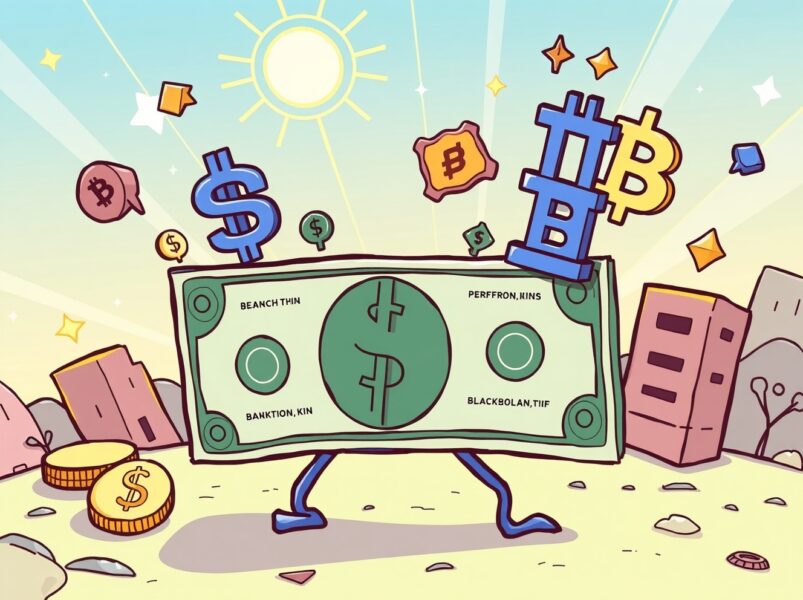Stablecoins: Eric Trump’s Bold Vision to Revolutionize the U.S. Dollar
0
0

BitcoinWorld

Stablecoins: Eric Trump’s Bold Vision to Revolutionize the U.S. Dollar
Eric Trump recently made a significant statement, suggesting that stablecoins could be the crucial innovation to safeguard the future of the U.S. dollar. This bold claim, shared in an interview with the New York Post, has ignited discussions across financial and cryptocurrency circles. But what exactly are stablecoins, and how might they play such a pivotal role in the global economy, especially concerning the world’s reserve currency?
Understanding the Power of Stablecoins
To grasp Eric Trump’s perspective, it is essential to understand what stablecoins are. Unlike volatile cryptocurrencies such as Bitcoin or Ethereum, stablecoins are digital assets designed to maintain a stable value. They achieve this stability by being pegged to a reserve asset, most commonly a fiat currency like the U.S. dollar, or sometimes to commodities or other cryptocurrencies. This pegging mechanism aims to combine the benefits of blockchain technology—speed, transparency, and borderless transactions—with the predictability of traditional currencies.
- Fiat-backed stablecoins: These are the most common type, holding an equivalent amount of fiat currency (e.g., USD) in reserve for every digital coin issued.
- Algorithmic stablecoins: These use smart contracts and algorithms to maintain their peg without direct fiat reserves.
- Commodity-backed stablecoins: Pegged to assets like gold or silver.
Why Eric Trump Believes Stablecoins Will Save the U.S. Dollar
Eric Trump’s conviction stems from the belief that stablecoins can modernize the U.S. dollar’s infrastructure, making it more competitive and resilient in an increasingly digital world. He specifically mentioned USD1, a stablecoin issued by WorldLibertyFinancial, as an example of this potential. His argument centers on several key advantages:
Firstly, efficiency in transactions. Stablecoins enable faster and cheaper international money transfers compared to traditional banking systems, which often involve multiple intermediaries and can take days to settle. This efficiency could enhance the dollar’s utility in global commerce.
Secondly, global accessibility. Stablecoins can reach populations worldwide, including those who are unbanked or underbanked, providing them with access to a stable, dollar-denominated digital asset. This broadens the dollar’s reach and influence.
Moreover, as nations explore central bank digital currencies (CBDCs), Eric Trump’s view suggests that privately issued stablecoins, especially those transparently backed by the U.S. dollar, could serve as a de facto digital dollar, reinforcing its status without direct government issuance. This approach could offer flexibility and innovation driven by the private sector.
The Benefits and Challenges of Embracing Stablecoins
The potential benefits of widespread stablecoin adoption are compelling:
- Reduced Transaction Costs: Lower fees for remittances and international payments.
- Faster Settlements: Near-instantaneous transfers, improving liquidity and efficiency in financial markets.
- Financial Inclusion: Providing digital access to a stable currency for individuals without traditional bank accounts.
- Innovation Catalyst: Fostering new financial products and services built on blockchain technology.
However, embracing stablecoins is not without its challenges. Regulatory clarity remains a significant hurdle. Governments worldwide are grappling with how to classify and oversee these digital assets, ensuring consumer protection, financial stability, and anti-money laundering (AML) compliance. Furthermore, the reserves backing stablecoins must be transparent and regularly audited to maintain trust and prevent systemic risks. The collapse of certain algorithmic stablecoins has highlighted the importance of robust backing mechanisms.
What Does This Mean for the Future of the U.S. Dollar?
Eric Trump’s comments highlight a growing recognition that digital assets are not merely a niche interest but a force shaping the future of global finance. Whether stablecoins ultimately “save” the U.S. dollar remains a subject of ongoing debate. However, their potential to enhance the dollar’s digital presence, improve transaction efficiency, and expand its global reach is undeniable. The conversation around stablecoins is evolving rapidly, urging policymakers and financial institutions to consider their role in maintaining the dollar’s preeminence.
The path forward will likely involve a collaborative effort between innovators, regulators, and financial experts to harness the advantages of stablecoins while mitigating their inherent risks. As the digital economy continues to expand, understanding and adapting to these technological shifts will be paramount for any currency aiming to retain its global influence.
FAQs About Stablecoins and the U.S. Dollar
Q1: What is a stablecoin?
A1: A stablecoin is a type of cryptocurrency designed to maintain a stable value, typically by being pegged to a reserve asset like the U.S. dollar.
Q2: How do stablecoins differ from Bitcoin?
A2: Unlike Bitcoin, which is highly volatile, stablecoins aim for price stability, making them more suitable for everyday transactions and as a store of value.
Q3: What are the main benefits of stablecoins for the U.S. dollar?
A3: They can offer faster and cheaper international transactions, expand the dollar’s global reach, and potentially enhance financial inclusion.
Q4: What are the risks associated with stablecoins?
A4: Risks include regulatory uncertainty, the need for transparent reserve management, and potential systemic risks if not properly overseen.
Q5: Will stablecoins replace the U.S. dollar?
A5: Most experts believe stablecoins are more likely to complement rather than replace the U.S. dollar, acting as a digital extension of its utility.
Did you find this article insightful? Share it with your friends and colleagues to spark a broader conversation about the future of finance and the role of digital assets. Your engagement helps us bring more crucial insights to the forefront!
To learn more about the latest crypto market trends, explore our article on key developments shaping stablecoins institutional adoption.
This post Stablecoins: Eric Trump’s Bold Vision to Revolutionize the U.S. Dollar first appeared on BitcoinWorld.
0
0
 Manage all your crypto, NFT and DeFi from one place
Manage all your crypto, NFT and DeFi from one placeSecurely connect the portfolio you’re using to start.




